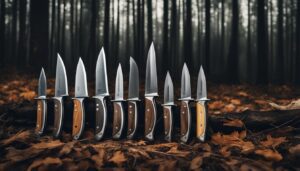When it comes to hunting, having the right knife can make all the difference. The length of the blade plays a crucial role in determining the knife’s effectiveness and efficiency. According to experts, the optimum blade length for a hunting knife ranges between 3.5 inches and 4 inches. This length provides a good balance between strength and versatility, allowing for easy skinning, field dressing, and other essential tasks. It’s important to choose a blade length that suits the type of game you typically hunt, as well as your own personal preferences and comfort.
Key Takeaways:
- Optimum blade length for hunting knives is typically between 3.5 and 4 inches.
- Choosing the right blade length is essential for effective and efficient hunting.
- Consider the type of game you hunt and your personal preferences when selecting a blade length.
- Blade length affects tasks such as skinning and field dressing.
- Balance strength and versatility with a blade length that suits your needs.
Types of Hunting Knives and Their Uses
When it comes to hunting, having the right knife can make all the difference. There are different types of hunting knives available, each with its own unique features and uses. By understanding the different types, you can choose the one that best suits your hunting style and needs.
Fixed-Blade Knives
Fixed-blade knives are the most popular choice among hunters for their strength and durability. These knives have a solid, non-folding blade that is permanently attached to the handle. They are known for their reliability and versatility, making them ideal for heavy-duty tasks such as skinning, quartering, and cutting through tough materials like bone. Fixed-blade knives are considered to be the strongest and most reliable option for hunting purposes.
Folding Knives
Folding knives, also known as pocket knives, are another common type of hunting knife. Unlike fixed-blade knives, folding knives have a blade that folds into the handle, making them more compact and portable. Folding knives offer convenience and versatility, as they can be easily carried in a pocket or backpack. These knives are suitable for lighter tasks such as field dressing, skinning small game, and general utility. They are a popular choice for hunters who prefer a compact and easy-to-carry option.
Specialty Knives
In addition to fixed-blade and folding knives, there are specialty knives designed for specific hunting tasks. These knives are tailored to perform a particular function with precision. Some examples of specialty knives include caping knives for delicate work like skinning around the head and neck, boning knives for removing meat from bones, and fillet knives for processing fish. Specialty knives are typically used in conjunction with a primary hunting knife and provide hunters with specialized tools for specific tasks.
| Type of Hunting Knife | Description | Uses |
|---|---|---|
| Fixed-Blade | Non-folding knife with a solid blade | Heavy-duty tasks, skinning, quartering |
| Folding | Knife with a blade that folds into the handle | Lighter tasks, field dressing, skinning small game |
| Specialty | Designed for specific hunting tasks | Caping, boning, filleting |
When choosing a hunting knife, consider the type that best suits your needs and preferences. Fixed-blade knives offer durability and strength, while folding knives provide portability and versatility. Specialty knives are ideal for hunters who require specialized tools for specific tasks. By understanding the different types of hunting knives and their uses, you can make an informed decision and find the perfect knife for your hunting adventures.
Anatomy of a Hunting Knife: Blade Shapes, Materials, and Handles
When it comes to selecting a hunting knife, understanding the anatomy of the blade is essential. The shape of the blade, the material it’s made of, and the handle design all play key roles in determining the knife’s performance and suitability for different hunting tasks.
Blade Shapes
Blade shapes vary, each with its own advantages and intended purposes. Drop point blades feature a convex curve from the spine to the tip, making them versatile and durable. They are suitable for a wide range of tasks, including skinning and field dressing game. Clip point blades, on the other hand, have a concave curve on the spine leading to a sharp point, offering excellent precision and control. These blades are popular for delicate operations like detail work and piercing. Gut hook blades, with a sharpened semi-circular notch close to the spine, are specifically designed for field dressing game and allow for easy opening of the animal’s abdominal cavity.
Blade Materials
The material used for the blade affects its sharpness, strength, and corrosion resistance. Stainless steel is a common choice for hunting knives due to its durability, resistance to rust, and ease of maintenance. It is available in various grades, with higher-quality stainless steel offering superior edge retention. High-carbon steel is another popular option for its exceptional hardness and edge retention, making it ideal for heavy-duty tasks. However, high-carbon steel blades require more maintenance to prevent corrosion.
Handles
The handle of a hunting knife is just as important as the blade itself. It should provide a comfortable grip and be made from durable materials. Synthetic handles, such as fiberglass-reinforced nylon or rubber, offer excellent grip and durability in various weather conditions. Wooden handles provide a traditional and aesthetic appeal, but they require more maintenance to prevent moisture damage. Some hunting knives also feature handles made from natural materials like bone or antler, which can add a unique touch to the knife but may be less practical in terms of durability.
Understanding the different blade shapes, materials, and handle options is crucial for choosing the right hunting knife. Consider the type of hunting you intend to do and the tasks you’ll frequently encounter. A versatile blade shape, such as a drop point, combined with a durable and corrosion-resistant material like stainless steel, can provide a reliable tool for a wide range of hunting scenarios. Additionally, selecting a handle material that offers a comfortable grip and suits your preferences will ensure a secure hold during use.
Setting Your Criteria
Before choosing a hunting knife, it’s important to establish clear criteria based on your needs, preferences, and budget. Determining the size of the knife that best suits your hunting game is crucial. A larger blade may be suitable for tasks such as field dressing larger animals, while a smaller blade may be more appropriate for smaller game. Consider the purpose of the knife as well, whether it is solely for skinning and field dressing or if you require additional features such as a gut hook or serrated edge.
Budget is another important factor to consider when setting your criteria. Determine how much you are willing to invest in a hunting knife, keeping in mind that higher-quality knives often come with a higher price tag. It’s important to strike a balance between cost and quality, ensuring that the knife meets your needs while staying within your budget.
When it comes to craftsmanship, you’ll need to decide whether you prefer a custom-made knife or a factory-made one. Custom knives offer personalized options and unique craftsmanship, often with higher attention to detail. However, they can be more expensive and may require a longer wait time. On the other hand, factory-made knives are often more affordable and readily available, but may lack the same level of craftsmanship and customizability.
By carefully considering your needs, size requirements, purpose, budget, and the significance of craftsmanship, you’ll be able to set clear criteria for choosing the perfect hunting knife that aligns with your preferences and ensures a successful hunting experience.

Table: Comparison of Custom-made and Factory-made Hunting Knives
| Custom-made Knives | Factory-made Knives | |
|---|---|---|
| Craftsmanship | High attention to detail | May vary in quality |
| Customizability | Offers personalized options | Limited options |
| Price | More expensive | More affordable |
| Availability | Longer wait time | Readily available |
| Quality | High-quality materials | Varies based on brand |
Conclusion
Finding the perfect hunting knife with the optimum blade length is crucial for a successful hunting experience. When it comes to the length of the blade, experts agree that it should fall between 3.5 inches and 4 inches. This range offers the right balance of strength and versatility for tasks like skinning and field dressing.
It’s also important to consider the type of hunting knife that suits your needs. Fixed-blade knives are known for their durability and strength, while folding knives offer portability and versatility. Specialty knives are designed for specific tasks, like caping or boning.
In addition to blade length and type, the materials used for the blade and handle are important factors to consider. Stainless steel blades offer durability, while high-carbon steel provides superior edge retention. Handles should provide a comfortable grip and be made from durable materials like synthetic materials, wood, or rubber.
Ultimately, your criteria for choosing the perfect hunting knife should be based on your needs, preferences, and budget. Whether you choose a custom-made knife or a factory-made one, prioritize quality craftsmanship and durability. By selecting the right hunting knife and properly maintaining it, you’ll be well-equipped for any hunting adventure.
FAQ
What is the optimum blade length for a hunting knife?
According to experts, the optimum blade length for a hunting knife ranges between 3.5 inches and 4 inches. This length provides a good balance between strength and versatility, allowing for easy skinning, field dressing, and other essential tasks.
What are the different types of hunting knives?
There are different types of hunting knives, including fixed-blade knives, folding knives, and specialty knives. Fixed-blade knives are known for their strength and durability and are ideal for heavy-duty tasks. Folding knives are more portable and versatile, making them suitable for lighter tasks or as a backup option. Specialty knives are designed for specific tasks such as caping, boning, and filleting.
What factors should I consider when choosing a hunting knife?
When choosing a hunting knife, it’s important to consider factors such as the type of knife, blade length, materials, and personal preferences. Think about the game you typically hunt and choose a size that suits your needs. Consider the purpose and intended use of the knife. Determine your budget and decide whether you prefer a custom-made or factory-made knife.
What are the common blade shapes, materials, and handles used in hunting knives?
Hunting knives come in various blade shapes such as drop point, clip point, and gut hook. The blade materials can include stainless steel for durability or high-carbon steel for superior edge retention. Handles are typically made from durable materials such as synthetic materials, wood, or rubber, and should offer a comfortable grip.
How do I find the perfect hunting knife?
To find the perfect hunting knife, consider the blade length, type of knife, materials, personal preferences, and budget. Choose a blade length that suits your hunting needs and tasks. Prioritize quality craftsmanship and durability. Properly maintain and care for your knife to ensure its longevity and performance in the field.





